The Best Canon Lenses for Travel - Epic Guide For EF and EF-S Mount
One of the best things you can do to improve your travel photography is to purchase a professional camera, and one of the worst things you can do is attach a cheap lens to it. While some "kit" lenses are ok and can be useful, it's not going to resolve enough detail for your DSLR's sensor. So that means your not letting getting the full potential out of your camera. I understand that you want to save money, but it's better to spend it on lenses than the camera itself; buy a used third generation Canon DSLR and slap an "L" lens on it and you'll produce some sharp travel images. With that said, we'll talk about how to find the best Canon DSLR Lenses for Travel.
But first, let's talk about the difference between EF and EF-S. Put simply; EF is made for full frame sized sensors (36mm x 24mm) while EF-S are made for APS-C sized sensor (22.3mm x 14.9mm). EF-S lenses were designed for use with Canon APS-C DSLRs while EF, which has been around since film days, are made for Canon full frame DSLRs. Since there are less glass and materials used to make EF-S lenses, they tend to be cheaper and lighter than their EF counterparts.
Best Canon Lenses Quick Overview
[ninja_tables id="24904"]
You should choose the right lens for the right body. Since the mount is practically made the same, you can fit an EF 16-35mm lens to your APS-C sized Canon 70d, however, since the image circle is larger, you won't get the same coverage as the EF-S equivalent of EF-S 10-22mm. So that means a 16-35mm on a full frame camera has a similar angle of view as a 10-22mm on an APS-C camera.
The Best Canon Lenses
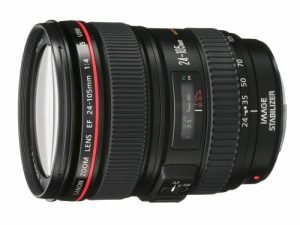
Canon EF 24-105mm f/4 L IS USM
MSRP: $899
Type: Wide-Telephoto
Weight: 27.6 oz.
Filter thread: 77 mm
Pros: Good coverage from wide-angle to moderate telephoto and has excellent contrast and color fidelity.
Cons: At f/4, it's a slow lens, and it's not particularly lightweight, and it's a little expensive.
Overview:
There's a new version of this lens, the Canon EF 24-105mm f/4L IS II USM, and both lenses aren't isn't cheap, but if your budget will stretch you may want to check either one. I only listed a preference to the first generation because it's just as sharp, and sharper in some instances according to DXOMARK than the newer version. So why not save a couple of hundred bucks and get a near perfect walk-around/travel lens?
The EF 24-105mm's picture quality is renowned among the most exceptional zoom lenses going around. This is an "L" designated lens by Canon - that's L for "Luxury." The focal length is broad and will cover various situations, and while f/4 isn't super fast, it will do fine in most lighting situations, particularly anything taken during daylight. It's got f/4 across all focal lengths so that it is quicker compared to 18-55mm at full extension.
This lens has Image Stabilization (IS) which will permit you to handhold shots at up to 2 stops faster than average and helps a little with the f/4 limitation. You're getting a lot of zoom coverage with this lens, and it could very well be a perfect "only" lens for travel. The autofocus is just plain masterful, it catches subjects fast and latches on; that's thanks to Canon's excellent Ring USM (Ultrasonic Motor) and as the moniker would suggest, also very quiet.
Obviously, for every positive, there is a negative, and this camera has. Namely, the Weight/Size - it isn't the lightest lens going around and having this thing with a DSLR hanging around your neck all day isn't comfortable. The price is also a little on the expensive side, but if you consider that it's going to be your "only" travel lens, then it's not so bad.
Canon EF 24-105mm f/4 L IS USM |
|
|---|---|
| Image Quality | 4 |
| Weight and Size | 4 |
| Convenience | 5 |
| Autofocus | 5 |
| Ergonomics | 4 |
See it on Amazon |
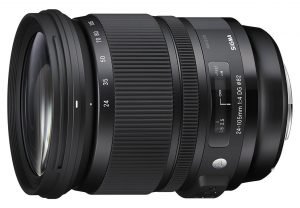 Sigma 24-105mm F4 DG OS HSM
Sigma 24-105mm F4 DG OS HSM
Although coming from a third party manufacturer, the Sigma 24-105mm F4 DG OS HSM is even sharper than the Canon EF 24-105mm f/4L IS II USM from the DXOMARK test mentioned above. Chromatic aberrations are worse on this lens, however, and it does suffer some astigmatism at 24mm.
It's not a big deal if you're not pixel peeping and I wouldn't hesitate to pick this one up at $899. This lens, like its Canon counterpart above, will fit your APC-S camera so that it can make a tremendous normal to telephoto travel lens.
See it on Amazon
Canon EF 24-70mm f/2.8 L II USM Lens
MSRP: $1,599
Type: Standard-Zoom
Weight: 27.6 oz.
Filter thread: 77 mm
Pros: Great image quality as indicative of the "L" label and fast at f/2.8 across all focal points.
Cons: Expensive, heavy, and lacking Image Stabilization (IS).
Overview:
The 24-70 L is a bread and butter for some professional photographers. The 24-70mm focal length range makes it possible for a massive group shot along with a close-up picture of the bride without a lens change. With a fixed highest f/2.8 aperture across the entire focal length range, this lens is easy to use and can be as quickly (wide aperture) like any Canon zoom lens created. If you're shooting inside museums or cathedrals, this zoom lens can't be beaten with the f/2.8 aperture. Billed as a wedding and portrait lens the Canon EF 24-70mm f/2.8 L II USM Lens does just as well as a travel lens if you don't need to get past 70mm.
There's some pincushion distortion at 70mm will also slim your subject a little and barely noticeable barrel distortion at 24mm. Because of the fast aperture, the lens has to have a lot of glass and with it more material into its construction, which makes this lens hefty and bulky. As a walk around lens, it might put a strain around your neck, so it might be a good idea to carry it on a top loading or shoulder sling bag. This also makes it a very expensive lens and to think the engineers at Canon could have had added IS to its frame, alas that isn't so.
There is a slower version, the Canon EF 24-70mm f/4.0L IS USM, that has Image Stabilization, but it's not nearly as good as this lens. The EF 24-70mm will fit on an APC-S size body (38.4-112mm), but you're better served to get the EF-S 17-55mm mentioned below. If picture quality is on the top of your requirements for a travel lens, then a few extra ounces wouldn't be much of an issue.
Canon EF 24-70mm f/2.8L USM |
|
|---|---|
| Image Quality | 5 |
| Weight and Size | 3 |
| Convenience | 5 |
| Autofocus | 5 |
| Ergonomics | 4 |
See it on Amazon |
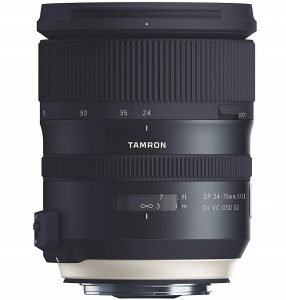 Tamron 24-70mm f/2.8 Di VC USD G2
Tamron 24-70mm f/2.8 Di VC USD G2
This lens is a great alternative to the Canon EF 24-70mm, an improved lens to its already good predecessor the G1. It also has its Anti-Shake technology to match the Canon IS called Vibration Compensation (VC), and it's about $500 cheaper. It has won a lot of fans, and for a good reason, this lens is sharp. There is some noticeable distortion at 24mm that can be a bit annoying to fix in Lightroom or Photoshop. Outside of that, this lens is built just as good as the Canon and easily its runner up.
You just have to ask yourself a question, how much is a few hundred bucks to you? A few hundred bucks can get about 20 days to stay in most hostels in Eastern Europe where you can focus on taking awesome travel photographs instead sweating over the pixel details that a brand name lens has over the other.
See it on Amazon
Canon EF-S 18-135mm f/3.5-5.6 IS USM Lens
MSRP: $276
Type: Standard-Telephoto
Weight: 16.0 oz.
Filter thread: 67 mm
Pros: Lightweight, small, 7.5x zoom ratio, Image Stabilization, good sharpness, and very cheap (currently).
Cons: Some distortion, dark corners at wide open apertures, and showing some softness at 35mm-50mm.
Overview:
On a Canon APC-S camera, the flexibility of such a focal range (28.8-216mm full frame equivalent) and its 7.5x zoom ratio is phenomenal. Like the former generation STM lenses, the EF-S 18-135mm has 16 elements in 12 groups. So if you've had any time on its predecessor or know a good deal about its production, then you'll have a good idea of what this little lens can do. This is the third iteration of the EF-S 18-135mm and boy did Canon step up to the plate to deliver. This latest one is given a Ring USM-Driven Auto-Focus, and that simply means silence, it's a quiet little lens.
The EF-S 18-135mm f/3.5-5.6 IS USM is an excellent travel lens. If your luggage size and weight are limited and you have very little room for photography gear, this lens will allow you to leave all your other lenses without suffering much in flexibility. There are very few lenses that can compare with the small size and weight while still offering the focal range and capabilities. It's also a joy to use as the lens isn't weighing you down on the field.
The variable max aperture f/3.5-5.6 will not put this in the "L" lens category, but the "IS" can compensate in most low light situations. Diffraction starts to show around f/5.9 and above, 35mm-50mm has some softness, but at 85mm it's plenty sharp. There's a little distortion and is dim in the corners when you shoot wide open, and you can fix it using lens profiles in Lightroom. Nitpicks aside, capturing the image is final indicator of what makes a good lens and the EF-S 18-135mm can capture great images just as good as any on this bunch.
Canon EF-S 18-135mm f/3.5-5.6 IS USM |
|
|---|---|
| Image Quality | 3 |
| Weight and Size | 5 |
| Convenience | 5 |
| Autofocus | 4 |
| Ergonomics | 4 |
See it on Amazon |
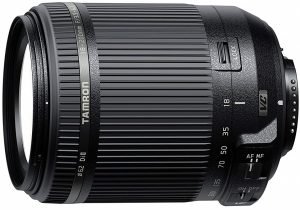 Tamron 18-200mm f/3.5-6.3 Di II VC Lens
Tamron 18-200mm f/3.5-6.3 Di II VC Lens
If you think the EF-S 18-135mm is a bargain, wait until you see the Tamron 18-200mm. It's running at $199 currently on Amazon. You also get longer reach than the Canon above. The Tamron is a budget lens, so you won't see a lot of metal in its construction. Zooming in and out isn't as smooth as some of the more premium lenses on this list.
The image quality is decent, with much of the sharpness achieved at f/8 (which is what I shoot with the most). There are some chromatic aberrations from 18mm to 100mm - easily fixed in Lightroom. The lens only weighs about 400 grams, and it does have Vibration Compensation. If you can shell out more money, I'd say go for the Canon above or jump into the "L" category. But if 200 bucks are all you can afford, this lens is a no-brainer.
See it on Amazon
Canon EF 50mm f/1.8 STM Lens
MSRP: $276
Type: Normal
Weight: 16.0 oz.
Filter thread: 67 mm
Pros: Super sharp, super fast, very cheap, and excellent build quality.
Cons: Limited in use and might be a redundant range in your lens arsenal.
Overview:
The 50mm f/1.8 II is the venerable lens in Canon's arsenal and remains an extremely popular lens. That's because of its super-fast f/1.8 aperture, very low price, and extremely sharp images even in amateur's hands. The new Canon EF 50mm f/1.8 STM is the replacement to that classic and Canon made some improvements while keeping the same weight/size and the cheap price. This lens produces professional quality imagery and does it all in a very small compact size, making it ideal to carry around in any luggage.
There is, of course, some things you are giving up like the ability to zoom in and out, for example. The focal range may also already fall in one of your ultra-zoom lenses, making it almost unnecessary and redundant. Other than that, nearly every photography schools (and thoughts) out there will highly recommend this lens. It's super fast and also sharp at f/1.8 allow you to shoot indoors and also achieve a very shallow depth of field. This new iteration also has better build quality with a metal mount instead of plastic.
Canon EF 50mm f/1.8 STM Lens |
|
|---|---|
| Image Quality | 5 |
| Weight and Size | 5 |
| Convenience | 3 |
| Autofocus | 5 |
| Ergonomics | 4 |
See it on Amazon |
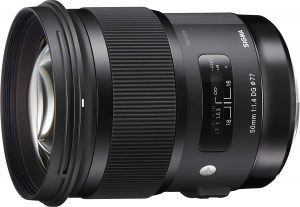 Sigma 50mm f/1.4 Art Lens
Sigma 50mm f/1.4 Art Lens
The Sigma 50mm f/1.4 Art isn't a competition to the Canon above per se. It's about seven times more expensive capping in at $713. It's just as sharp (even sharper in some tests) and just as good the 50mm above. What it does offer, is the fact that it's got turbo overdrive aperture at f/1.4 and that means you very narrow DOF and very fast. When you start to make lenses on the sub f/1.4 range things, start to get very expensive, and the glass starts to get bigger as well.
Why f/1.4? It allows you to shoot in low light conditions that you normally wouldn't be able to do. Shooting interiors hand-held would be boon with this lens. That is if you're willing to shell out the money for it.
See it on Amazon
Canon EF 16-35mm f/2.8 L USM Lens
MSRP: $1,899
Type: Superwide-Standard
Weight: 1.74 pounds
Filter thread: 88 mm
Pros: Excellent image quality as indicative of the "L" moniker and fast at f/2.8 with an added Image Stabilization.
Cons: Expensive, heavy, and the 82mm filter thread needs additional filters.
Overview:
For some travel photographers who are going to be taking primarily landscape or, perhaps, a lot of interior photos, then the Canon EF 16-35mm f/4.0L IS USM is a no-brainer. With astounding optical performances that is also a relatively lightweight, robust construction, the 16-35mm can be the very best Canon travel lens for landscape photographers. The lens is sharp at just about any aperture until f/16 when diffraction sets in; no worries, I shoot at f/22 with this lens all the time to get sunburst effect - at no point do I ever complain about diffraction.
Chromatic Aberration is well controlled throughout as well as distortion, which is quite atypical in wide zooms. The corners do show some vignetting that is every present regardless of what aperture you use but, like distortion, can be alleviated in post-processing. You could opt for the cheaper Canon EF 16-35mm f/4.0 L IS USM if you don't need the extra stop in aperture but not be suitable for specific shots like as astrophotography. The f/2.8 is also equipped with Images Stabilization, so your capabilities during low-light conditions are considerably higher than the f/4 version. The image quality is superb, it may even rival if not equal some of Canon's prime lenses, and that's saying a lot.
The f/2.8 does give you more heft than the f/4, and if you're the type that is bothered by heavy luggage, then that's something you have to consider. The Canon EF 16-35mm f/2.8 is one of the designated "L" lenses which makes one of the best in their line-up. One little quip is the 82mm filter thread; most photographers have 77 mm filters with step down rings to fit other lenses, having a bigger 82mm means buying another filter.
Canon EF 16-35mm f/2.8 L USM |
|
|---|---|
| Image Quality | 5 |
| Weight and Size | 3 |
| Convenience | 4 |
| Autofocus | 5 |
| Ergonomics | 5 |
See it on Amazon |
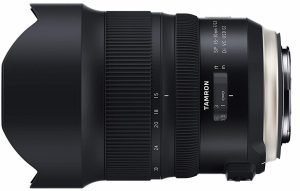 Tamron 15-30mm f/2.8 Lens
Tamron 15-30mm f/2.8 Lens
You'd think that there's no match for the Canon EF 16-35mm after my awesome review, but that's not the case, it has a contender in the Tamron 15-30mm f/2.8. Though it doesn't bare the Canon logo, the Tamron is giving Canon a run for its money. It comes with stabilization at f/2.8 giving you endless possibilities in low light conditions and the stabilization works very well.
The autofocus is also very fast and is quite a ninja when searching for its target. The image quality is superb and just as good as any lenses mentioned here. There are some glaring issues, one with the lack of filter ring (so you can't mount any filters on it) and does require a special adapter if you would like to use filters.
For the price, it's about $500 cheaper than the Canon above, and this might just be the lens of choice. I have the Sony version of this lens and can attest to its superb construction and image quality - a little bummed about the lack of the filter but then again, I've never seen the need to use a Polarizer on it (it's too wide). If you don't care that you're shooting with a non-brand name lens and also care about quality, then grab this lens!
See it on Amazon
Canon EF 11-24mm f/4.0 L USM
MSRP: $2,699
Type: Superwide-Zoom
Weight: 2.6 pounds
Filter thread: n/a
Pros: There is no other lens like this in circulation, controlled distortion at 11mm, and excellent sharpness.
Cons: Very Expensive, very heavy, and too specialized.
Overview:
I've owned the Canon 8-15mm Fisheye previously and enjoyed using it. However, I didn't use it often enough to justify keeping it. I love the super wide angle look but didn't like how distorted the fisheye made the images be. It has its application, but it's fairly limited. In comes the 11-24mm. Now, this super wide zoom lens lets you capture everything around you and doesn't look crazily distorted like the fisheye lens. While the benchmark 11mm focal length gets all the attention, it does let you go far with a bump up to 24mm range that is more on the standard wide-angle focal point.
For as wide as the EF 11-24mm f/4.0 L is, distortion is surprisingly controlled - I don't know what sort of physics the Canon engineers applied on this one, but they're getting an A+ from me! You'll never see any 11mm without nary a distortion, and no lens on this planet can match it. This lens is probably not for every traveler. It's kind of a specialized lens. You really have to like that super wide angle look to even consider this lens. This would be more popular to photographers who do a lot of landscape and seascapes scenery (raises hand) during travels.
The EF 11-24mm f/4.0 L would be a fine companion to a 24-200mm range type of zoom lenses. If you have one of those, you got everything pretty much covered. However, I suspect the 16-35mm is more than enough for most people - shelling out almost 3k for a specialized lens is also an otherworldly decision. To achieve this level of quality means a lot of materials (glass and metal) are being used, making this a very heavy lens at 2.6lbs. However, if you have the money, go for it!
Canon EF 11-24mm F/4.0 L USM |
|
|---|---|
| Image Quality | 5 |
| Weight and Size | 3 |
| Convenience | 4 |
| Autofocus | 5 |
| Ergonomics | 4 |
See it on Amazon |
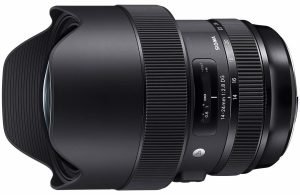 Sigma 14-24mm f/2.8 DG HSM
Sigma 14-24mm f/2.8 DG HSM
The engineers at Canon may have perfected the super wide range, but you must give credit to Sigma for trying. And try they did, with the 14-2mm f/2.8 DG HSM and they even did something better - they got it down a whole stop down at f/2.8 (minus the 11-13mm of course). You're also not losing $2,699 out of your pocket because this baby is contending at just $1,179.99 which makes it well within your lonesome to give this lens a hard look.
It's not going to beat the Canon above in term of sharpness (I think that's impossible at this point). This lens doesn't handle distortion as well as the lens it's challenging but what but in use, it's more than good enough. So, why this lens instead of the Canon? It's f/2.8, silly! If you even consider astrophotography this is a no brainer. The Canon might run circles around this lens but when it comes to shooting the stars, get out of here. This lens is worth a look!
See it on Amazon
Canon EF-S 17-55mm f/2.8 IS USM
MSRP: $549
Type: Wide-Telephoto
Weight: 1.42 pounds
Filter thread: 77 mm
Pros: Excellent image quality as indicative of the "L" moniker and fast at f/2.8 with an added Image Stabilization.
Cons: Expensive, heavy, and the 82mm filter thread needs additional filters.
Overview:
This is fast zoom lens with decent range, and if you do not need anything longer or wider, this will be the last lens you'll ever need to purchase for your APC-S camera. Forget the new camera, get this lens instead and rest easy knowing you'll get the best imagery out of your photography equipment. The zoom range pretty covers 90% of all travel situations, and it's also fast at f/2.8. The EF-S 17-55mm f/2.8 produce sharp images without stopping down too much unlike other cheaper zoom lenses. This lens also makes your photos pop with its color and contrast renditions.
The USM (Ultra Sonic Motor) make the EF-S 17-55mm f/2.8 very quiet and a joy to use. The autofocus is spot on target and can lock on to its targets like a heat-seeking missile, and the IS make it a very stable ship, giving you a few extra stops (on top of the f/2.8) to work within low light conditions. The 77mm filter thread is welcome as it will give you lots of options to work with. With all the quality glass on this lens, it's not the lightest lens on this list. Quite heavy in fact for an EF-S lens and might be off balance with lighter DSLRs like the Rebel. It's not an "L" lens and isn't made with metal, but even though it's made of plastic, it doesn't feel plasticky.
Canon EF-S 17-55mm f/2.8 IS USM |
|
|---|---|
| Image Quality | 5 |
| Weight and Size | 4 |
| Convenience | 4 |
| Autofocus | 5 |
| Ergonomics | 5 |
See it on Amazon |
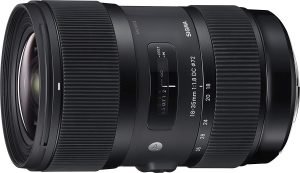 Sigma Art 18-35mm f/1.8 DC HSM
Sigma Art 18-35mm f/1.8 DC HSM
This lens comes in to challenge the brand name above, and it does very well. At f/1.8, it's one of the fastest zooms out there. You're going to pay a little bit more for that feature at 150 dollars on top of the Canon, but a stop faster is definitely worth the expense if you're going to be using the lens in low light and hand-held situations.
This lens is in one of those instances where a third-party manufacturer actually beats Canon. This lens is sharper in some DXOMARK scores and worth a look at before taking a dive on the Canon.
See it on Amazon
Canon EF-S 10-18mm f/4.5-5.6 IS STM
MSRP: $269
Type: Superwide-Normal
Weight: 15.5 ounces
Filter thread: 67 mm
Pros: Excellent image quality as indicative of the "L" moniker and fast at f/2.8 with an added Image Stabilization.
Cons: Expensive, heavy, and the 82mm filter thread needs additional filters.
Overview:
If you're looking for an affordable superwide angle zoom for your APC-S camera, then look no further. This lens is lightweight with built-in IS and just as sharp as its more expensive and faster brother, the Canon EF-S 10-22mm, but you can't really go wrong with either one. It seems like Canon just ran out any ideas for new lenses and decided to build similar ones on the same range. For travel, however, I would have to give the edge to the 10-18mm.
Together with the EF-S 10-18 STM IS at its lineup, Canon is sure to increase its ultra-wide angle zoom lens reputation significantly. The Canon EF-S 10-18mm f/4.5-5.6 IS STM has good image quality and autofocus accuracy that competes closely with currently available lenses within this class. Although this lens gets the narrowest highest aperture of those lenses, not one of the others offer IS. It's not the fastest lens at the variable f-stops, but the added IS helps a bit.
The EF-S 10-18mm f/4.5-5.6 IS STM's construction isn't going to win any hardcore battles, but it's sturdy enough and as small as it is, shouldn't have a lot of opportunities for crashes and massive drops. The ultra-wide, ultra-light, ultra-small, ultra-affordable Canon EF-S 10-18mm f/4.5-5.6 IS STM Lens will be a no-brainer option for a high number of all APS-C DSLR travel kits.
Canon EF-S 10-18mm f/4.5-5.6 IS STM |
|
|---|---|
| Image Quality | 3 |
| Weight and Size | 5 |
| Convenience | 4 |
| Autofocus | 4 |
| Ergonomics | 5 |
See it on Amazon |
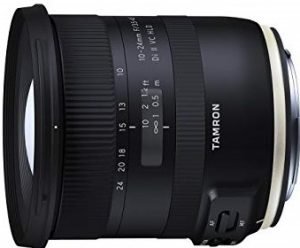 Tamron 10-24mm f/3.5-4.5 Di II VC HLD
Tamron 10-24mm f/3.5-4.5 Di II VC HLD
This tiny little lens is worth a look at. It's around 3.3 inches in diameter but features a 77mm filter thread. It's fairly weather sealed due to its solid construction. When it comes to image quality, it's plenty sharp. Though there's some noticeable drop in sharpness on the corners of the image when shot wide open.
You can stop the lens down further to gain more sharpness, but then you start to suffer from diffraction (at f/11 onwards). I say at f/8 (my favorite f-stop), it's pro-quality and you're good to go. The Vibration Compensation lets you get away with hand-holding shakes but don't expect much from its max f/3.5-4.5 variable aperture.
See it on Amazon
Canon EF-S 18-200mm f/3.5-5.6 IS
MSRP: $699
Type: Superwide-Telephoto
Weight: 1.3 pounds
Filter thread: 72 mm
Pros: Great range with wide to telephoto, Image Stabilization, can be a one and only lens.
Cons: Not as sharp as "L" lenses, variable and slow aperture.
Overview:
The Canon 18-200mm ƒ/3.5-5.6 IS covers a lot of ground. Most superzoom lenses we know, while offering the convenience, tend to underperform optically. Not so with this lens. It offers slightly better performance than other lenses of this class and all packaged into a really small portable lens. This makes it an ideal "only" walk around travel lens. The Image Stabilization is a nice touch, and that should alleviate some of the variable aperture's shortcomings. It's not the cheapest lens around, and it's actually priced quite conservatively. But considering you don't need to buy other lenses with this lens' coverage, it's a steal.
The Canon EF-S 18-200mm f/3.5-5.6 IS will free you of the burden of taking a backpack full of lenses. Traveling simple, traveling light while still having good focal range is this lens' draw. If you absolutely must only carry one lens with you on a trip, then this lens is for you. It doesn't offer optical perfection as other lenses on this list will probably run circles around this one. For a majority of the scenarios, you'll face while traveling this lens has you covered.
Canon EF-S 18-200mm f/3.5-5.6 IS |
|
|---|---|
| Image Quality | 4 |
| Weight and Size | 4 |
| Convenience | 5 |
| Autofocus | 5 |
| Ergonomics | 5 |
See it on Amazon |
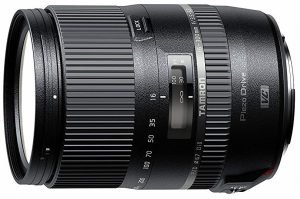 Tamron 16-300mm f/3.5-6.3 Di II VC PZD Macro
Tamron 16-300mm f/3.5-6.3 Di II VC PZD Macro
This is one lens that's trying to be the be-all and end-all for all your focal needs. It even goes so far as to cover the macro range. But how does it stack up? I'm usually very skeptical of these kinds of lenses because the extreme zoom it has to cover. It usually means more glass and elements have to go into the construction of the lens. But you know what? This lens isn't half bad.
Some pundits slam it for the not so perfect optical performance, but they also slam one of my favorite lenses of the same range — the Sony 24-240mm for the same reasons. Baloney, I say. This lens is a jack-of-all-trades and as such good a most and master of none. If I were to pick to absolutely pick only one lens to travel with, I'd have a hard time making my mind up over this at the Canon above.
See it on Amazon
How to Find the Best Canon Lenses
Deciding on which lens to use for travel is different than choosing which lens to use every day. Weight and size, for example, come into the fray when choosing the best travel lens. It's a matter of which one won't' compromise the image quality as much while still being able to fit in your luggage. While it would be awesome to be able to use all our lenses on all our trips, that's simply not possible unless you have a dedicated Sherpa following you around.
Naturally, however, there are always likely to be more compromises - it's impossible to find a perfect lens that does everything, doesn't cost too much, and is also lightweight! For travel photography, it is better to focus on getting a few collections of lenses that have wide coverage rather than a lof for every scene.
You can even just get a single lens like an 18-200mm, this focal range pretty much got you covered. It will likely not be fast enough, but if you need speed, you can pair it with an f/1.8 50mm.
Some cameras come packaged with a kit lens, and sometimes these ones can be good and have good focal range. Eventually, you'll end up outgrowing the lens will want something more substantial. It's a good idea to keep in mind what your focal range you find yourself shooting with and what aperture. This way, you can narrow down the lens choices in the future. For example, I find myself shooting on a tripod at f/8 and above 95% of the time. It wouldn't make sense for me to spend more money and get a very expensive f/2.8 lens
Price Considerations
Speaking of money, the more expensive the lens, the better it tends to be. These lenses are usually made with metal bodies and more elements making them heavier and bulkier. So you have to keep that in mind because having the sharpest lens around that's weighing you down may discourage you from taking it everywhere. I've provided plenty of options for travel above and there's plenty of budget options that doesn't compromise image quality.
If you're a tight budget, consider getting your lenses from Ebay, there you can find second-hand lenses and also international ones for cheap.
Aperture
Think of aperture as like the "iris" (that controls the pupil) of your eyes. As you focus on an object close to you, you will notice the surrounding area is blurred out. If somebody were looking at your eye's pupil, they would notice that it was opening up. The same concept on camera lenses. The bigger the aperture, the more light gets in and the narrow your Depth Of Field. If you were to try to get everything in focus of the scene in front of you, your pupil would close down smaller. On the lens, the aperture will be smaller and the wider the DOF.
Inside a lens, there's a hole that lets the light through to the camera's sensor. This gap is also referred to as an aperture. An aperture can change in proportion, with a larger aperture allowing more light, and also a bigger aperture allowing less light inside.
Why does it matter? Your controls how much light gets into your eyes, and the same is true of the aperture. If you're inside a dark interior, you would need to have the aperture open up so more light can get into the sensor. Usually, a super-zoom lens will have a smaller max aperture. That's why it's nice to have a cheap 50mm f/1.8 lens around in case you're ever in a situation where you are shooting in low light conditions.
Focal Length
The focal length of a lens is related to how much magnification it provides and is measured in millimeters. The greater this number is, i.e., 18-300mm, the greater the magnification the lens can achieve. Remember I was talking about the difference between EF and EF-S? Will that makes things confusing here. A 50mm on a full frame camera, like Canon 5d MK IV, is truly a 50mm. However, on an APC-S camera like the Rebel, it's actually 80mm. Generally, Canon's APC-S sensors have a crop factor of 1.6 compared to full frame sensors.
It's easy to do the math to get the equivalent focal range between them. Just take whatever full frame focal length you see and multiply it by 1.6, and vice versa take a cropped focal length and dived it by 1.6. Easy peasy. If you've failed your elementary algebra in 5th grade then simple use this Calculator and be done with it.
I've already done all the research for you on this epic guide. The lenses mentioned here will give you plenty of coverage on the most focal range you'll every use while traveling.
Convenience
This can be subjective and depends really on what your predispositions are as a photographer. Here, I mark convenience as to how much can the lens do to any given situation. Sort of like a one and only lens (which is improbable) - this takes into account the focal length, weight, size, and aperture or a combination of other things not necessarily a feature of the lens itself. Like, what sort of situations are being shot in your travels for example.
Image Stabilization
It's amazing how far manufacturers have gone with Image Stabilization technology. There's a mechanism in place (electronic or otherwise) that compensate for the movement caused by you, the photographer. For Canon, it's sometimes built into the lens and will be noted as such with the "IS" moniker. For Tamron it's "VC" for Vibration Compensation and Sigma it's "VR" for Vibration Reduction. Whatever acronym they stick to the lens, they mean the same thing.
What's it good for? It allows you to shoot at shutter speeds at 2 stops or more than you normally would while handholding without blurring the image. I'm usually shooting with a tripod, so I don't need this feature as much personally. ut if you love holding the camera on your hands then this feature becomes of paramount importance. Some really good "IS" technology can even go as far as 5 stops of vibration reduction. Having this feature on your lens or camera can make or break an image, so it's an important feature to consider.
Weight
No brainer here. Weight matters when you are traveling. Period. You have to take into account all your other belongings and on top of that also your camera gear. You'll appreciate that lightweight camera and lens combination when you have around your neck for a day's worth of shooting. You'll certainly appreciate having a few pounds shaved off your backpack when you're going on long distance hikes.
All of the lenses recommended here has already taken weight into consideration. If there's lens suggested that's heavy, it's only because its merit outweighs (literally) the weight factor. Like the 16-35mm f/2.8 for example, it's almost 2 lbs, but I wouldn't ever complain how heavy it is because it's a joy to use and can capture images no other lightweight lens can.
Size
If it's taking too much space on your luggage or backpack, then there's something wrong. Maybe you're out shooting wildlife overseas and in which case you have every excuse to ignore what I wrote here. My recommendations here don't cover the extreme telephotos the size of a jumbo jet; I don't think they're ideal for 95% of travelers.
The general rule of thumb is: the larger the focal range and the larger the max aperture, the bigger the lens is. More glass, more elements, more metal is what requires to make a lens be fast and reach long. Somewhere and somehow, you'll have to start to make compromises, and I've laid that out in all the lenses on this list to help you make a sound decision.
Autofocus
If you've ever spent time with old manual focus lenses, then you can appreciate what godsend autofocus lenses are to a camera. Autofocus (AF) systems use one or more sensors to determine the right focus. Some even use an array of sensors to get the right focus. Modern DSLR cameras from Canon use a through-the-lens optical sensor which is very speedy and very accurate.
AF is a very important factor to consider when you purchase your lens. It can mean the difference between getting that perfect right in the moment shot or losing that opportunity. Luckily, I've made sure that all lenses listed here meet or exceeds the standards for AF.
Ergonomics
This is an important consideration when you're looking for your next travel lens. Nobody wants to carry, let alone use, a lens that's difficult to use. How smooth is it to zoom the lens? How well does it pair with the camera? This feature is often overlooked when choosing a travel lens. I've also taken this into account from all the lens presented here.
Bottom Line
Choosing the best lens to take with you in your travels doesn't have to be rocket science. I have presented the best lens line-up here from Canon that's great for travel. Whether you have Rebel APC-S or a 5D MK IV full frame, these lenses are the best of their kind in this category.
WHAT'S YOUR FAVORITE CANON TRAVEL LENS?
#Oringinally post at Always Wanderlust - The Best Canon Lenses for Travel
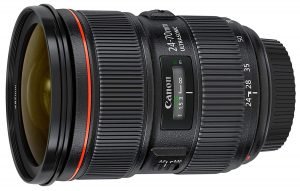
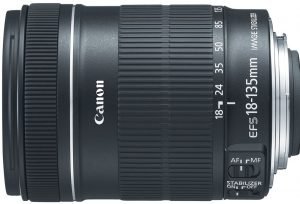
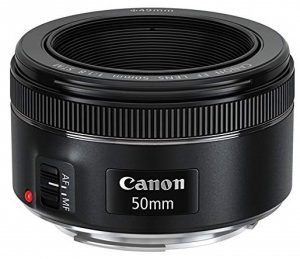
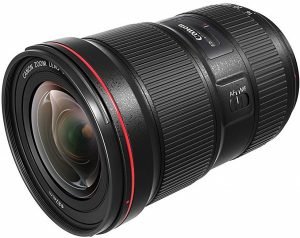
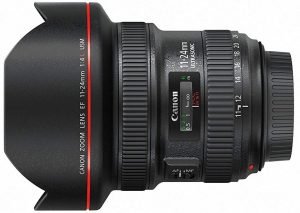
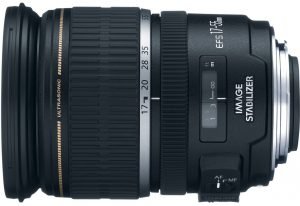
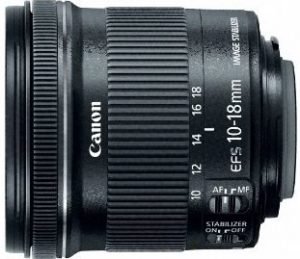
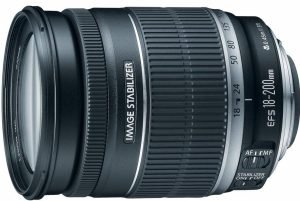

Great post! Love how many options are there and all the details! Personally, I'm taking with me only my little GoPro but my sister would love to read more about this and will definitely send it out :)